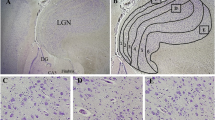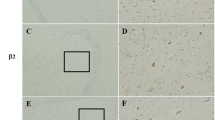Abstract
The purpose of this study was to examine the neuronal expression of apoptotic markers in the rostral medulla of a newly characterized dataset of sudden unexpected death in infancy (SUDI), and to determine the impact of diagnostic groupings on these findings and whether they pertain to the intrinsic apoptotic pathway. Immunohistochemical staining was quantified to determine the percentage of neurons positive for active caspase-9 (specific to the intrinsic apoptotic pathway), active caspase-3 (common to the intrinsic and extrinsic apoptotic pathways) and Terminal deoxynucleotidyl transferase mediated dUTP nick-end labelling (TUNEL) (labels DNA fragmentation) in nine nuclei of the rostral medulla. Expression was compared between groups of SUDI infants where the cause of death was initially classified by a forensic pathologist or subsequently after reclassification by an expert panel using the San Diego Criteria. 68 SUDI infants were studied and originally classified as explained SUDI (n = 12), Sudden Infant Death Syndrome (SIDS) (n = 27) and undetermined (n = 29). Reclassification resulted in a decrease in the number of explained SUDI cases to 7 and a decrease in the number of undetermined cases to 4, with a corresponding increase in the number of SIDS cases to 57 (8 SIDS I; 49 SIDS II). The expression of apoptotic markers was similar in explained SUDI and SIDS I infants. However, TUNEL expression was greater in the cuneate (p < 0.001), vestibular (p = 0.01) and hypoglossal (p < 0.001) nuclei and active caspase-3 expression was lower in the arcuate nucleus (p = 0.037) in SIDS II compared to explained Sudden Unexpected Death in Infancy (eSUDI) infants. Compared to SIDS I infants, SIDS II infants had greater TUNEL expression in the dorsal motor nucleus of the vagus (p < 0.01) and greater active caspase-9 expression in the medial and spinal vestibular nuclei (p = <0.01). Changes in apoptotic expression predominated in SIDS II infants. We postulate that these are due to a combination of contributing risk factors including the presence of an upper respiratory tract infection and bed-sharing/co-sleeping. The absence of changes in active caspase-9 expression compared to eSUDI indicates that the intrinsic apoptotic pathway is not upregulated in SIDS.



Similar content being viewed by others
Explore related subjects
Discover the latest articles and news from researchers in related subjects, suggested using machine learning.Change history
26 January 2019
A Correction to this paper has been published: https://doi.org/10.1007/s12024-019-0087-y
References
Fleming P, Blair P, Bacon C, Berry J. Sudden unexpected deaths in infancy: the CESDI SUDI studies 1993–1996. London: The Stationery Office; 2000. p. 1–5.
Krous HF, Beckwith JB, Byard RW, Rognum TO, Bajanowski T, Corey T, et al. Sudden infant death syndrome and unclassified sudden infant deaths: a definitional and diagnostic approach. Pediatrics. 2004;114:234–8.
Byard RW, Marshall D. An audit of the use of definitions of sudden infant death syndrome (SIDS). J Forensic Legal Med. 2007;14:453–5.
Hunt CE, Darnall RA, McEntire BL, Hyma BA. Assigning cause for sudden unexpected infant death. Forensic Sci Med Pathol. 2015;11:283–8.
Garcia AJ, Koschnitzky JE, Ramirez JM. The physiological determinants of sudden infant death syndrome. Respir Physiol Neurobiol. 2013;189:288–300.
Neary MT, Breckenridge RA. Hypoxia at the heart of sudden infant death syndrome? Pediatr Res. 2013;74:375–9.
Yue X, Mehmet H, Penrice J, Cooper C, Cady E, Wyatt J, et al. Apoptosis and necrosis in the newborn piglet brain following transient cerebral hypoxia–ischaemia. Neuropathol Appl Neurobiol. 1997;23:16–25.
Boatright KM, Salvesen GS. Mechanisms of caspase activation. Curr Opin Cell Biol. 2003;15:725–31.
Annunziato L, Amoroso S, Pannaccione A, Cataldi M, Pignataro G, D'Alessio A, et al. Apoptosis induced in neuronal cells by oxidative stress: role played by caspases and intracellular calcium ions. Toxicol Lett. 2003;139:125–33.
Elmore S. Apoptosis: a review of programmed cell death. Toxicol Pathol. 2007;35:495–516.
Machaalani R, Rodriguez M, Waters K. Active caspase-3 in the sudden infant death syndrome (SIDS) brainstem. Acta Neuropathol. 2007;113:577–84.
Machaalani R, Waters KA. Neuronal cell death in the sudden infant death syndrome brainstem and associations with risk factors. Brain. 2008;131:218–28.
Waters KA, Meehan B, Huang J, Gravel RA, Michaud J, Côté A. Neuronal apoptosis in sudden infant death syndrome. Pediatr Res. 1999;45:166–72.
Machaalani R, Waters KA. Increased neuronal cell death after intermittent hypercapnic hypoxia in the developing piglet brainstem. Brain Res. 2003;985:127–34.
Paxinos G, Huang X-F. Atlas of the human brain stem. San Diego: Academic Press; 1995.
Blair PS, Byard RW, Fleming PJ. Sudden unexpected death in infancy (SUDI): suggested classification and applications to facilitate research activity. Forensic Sci Med Pathol. 2012;8:312–5.
Machaalani R, Waters KA. Neurochemical abnormalities in the brainstem of the sudden infant death syndrome (SIDS). Paediatr Respir Rev. 2014;15:293–300.
Paine SM, Jacques TS, Sebire NJ. Review: neuropathological features of unexplained sudden unexpected death in infancy: current evidence and controversies. Neuropathol Appl Neurobiol. 2014;40:364–84.
Sparks LD, Hunsaker JC. Neuropathology of sudden infant death (syndrome): literature review and evidence of a probable apoptotic degenerative cause. Childs Nerv Syst. 2002;18:568–92.
Kahn A, Groswasser J, Rebuffat E, Sottiaux M, Blum D, Foerster M, et al. Sleep and cardiorespiratory characteristics of infant victims of sudden death: a prospective case-control study. Sleep. 1992;15:287–92.
O'Kusky JR, Norman MG. Sudden infant death syndrome: increased number of synapses in the hypoglossal nucleus. J Neuropathol Exp Neurol. 1995;54:627–34.
Krajewski S, Krajewska M, Ellerby LM, Welsh K, Xie Z, Deveraux QL, et al. Release of caspase-9 from mitochondria during neuronal apoptosis and cerebral ischemia. Proc Natl Acad Sci U S A. 1999;96:5752–7.
Nakajima W, Ishida A, Lange MS, Gabrielson KL, Wilson MA, Martin LJ, et al. Apoptosis has a prolonged role in the neurodegeneration after hypoxic ischemia in the newborn rat. J Neurosci. 2000;20:7994–8004.
Porzionato A, Macchi V, Guidolin D, Sarasin G, Parenti A, Caro RD. Anatomic distribution of apoptosis in medulla oblongata of infants and adults. J Anat. 2008;212:106–13.
Snider BJ, Gottron FJ, Choi DW. Apoptosis and necrosis in cerebrovascular disease. Ann N Y Acad Sci. 1999;893:243–53.
Wang X, Zhu C, Wang X, Hagberg H, Korhonen L, Sandberg M, et al. X-linked inhibitor of apoptosis (XIAP) protein protects against caspase activation and tissue loss after neonatal hypoxia–ischemia. Neurobiol Dis. 2004;16:179–89.
Bigio MRD, Beckery LE. Microglial aggregation in the dentate gyrus: a marker of mild hypoxic-ischaemic brain insult in human infants. Neuropathol Appl Neurobiol. 1994;20:144–51.
Jones KL, Krous HF, Nadeau J, Blackbourne B, Zielke HR, Gozal D. Vascular endothelial growth factor in the cerebrospinal fluid of infants who died of sudden infant death syndrome: evidence for antecedent hypoxia. Pediatrics. 2003;111:358–63.
Leech RW, Alvord EC. Anoxic-ischemic encephalopathy in the human neonatal period: the significance of brain stem involvement. Arch Neurol. 1977;34:109–13.
Quattrocchi CC, Fariello G, Longo D. Brainstem tegmental lesions in neonates with hypoxic-ischemic encephalopathy: magnetic resonance diagnosis and clinical outcome. World J Radiol. 2016;8:117.
Daugas E, Nochy D, Ravagnan L, Loeffler M, Susin SA, Zamzami N, et al. Apoptosis-inducing factor (AIF): a ubiquitous mitochondrial oxidoreductase involved in apoptosis. FEBS Lett. 2000;476:118–23.
Susin SA, Daugas E, Ravagnan L, Samejima K, Zamzami N, Loeffler M, et al. Two distinct pathways leading to nuclear apoptosis. J Exp Med. 2000;192:571–80.
Stecco C, Porzionato A, Macchi V, Sarasin G, Calcagno A, Parenti A, et al. Detection of apoptosis in human brainstem by TUNEL assay. Ital J Anat Embryol. 2004;110:255–60.
Acknowledgements
The tissue used in this study was provided by the NSW Forensic and Analytical Science Service. The authors acknowledge the facilities, and scientific and technical assistance of the Australian Microscopy and Microanalysis Research Faculty at the Australian Centre of Microscopy and Micro Analysis, University of Sydney. Research was funded by the SIDS Stampede, Australia, and the Miranda Belshaw Foundation.
Funding
This study was funded by philanthropy (SIDS Stampede, Australia and the Miranda Belshaw Foundation, Australia).
Author information
Authors and Affiliations
Corresponding author
Ethics declarations
Informed consent
This type of study no formal consent was required.
Conflict of interest
The authors declare that they have no conflict of interest.
Ethical approval
Ethical approval was from the NSW Health RPAH Zone (X13–0038 & HREC/13/RPAH/54) and University of Sydney Ethic committees.
Electronic supplementary material
ESM 1
(PDF 178 kb)
Rights and permissions
About this article
Cite this article
Ambrose, N., Waters, K.A., Rodriguez, M.L. et al. Neuronal apoptosis in the brainstem medulla of sudden unexpected death in infancy (SUDI), and the importance of standardized SUDI classification. Forensic Sci Med Pathol 14, 42–56 (2018). https://doi.org/10.1007/s12024-018-9954-1
Accepted:
Published:
Issue Date:
DOI: https://doi.org/10.1007/s12024-018-9954-1




